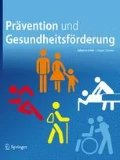Zusammenfassung
Hintergrund
In der Palliativversorgung geht es nicht nur um die Betreuung unheilbar Kranker in der Terminal- und Finalphase, sondern auch um eine angemessene frühzeitige Integration des Palliative Care-Ansatzes in die bestehenden Versorgungsbereiche. Ziel dieser Arbeit ist es, Berührungspunkte zur Prävention herauszuarbeiten.
Methoden
Es wurde eine systematische Literaturrecherche zu Prävention und Palliativversorgung in „PubMed“ für die letzten 5 Jahre sowie eine freie Recherche in ausgewählten Fachbüchern durchgeführt. Aus den Inhalten der Beiträge wurden thematische Kategorien generiert. Die identifizierten Publikationen wurden den Kategorien zugewiesen sowie formal und inhaltlich analysiert.
Ergebnisse
Die Zeitschriftenrecherche ergibt 223 Treffer. Größter inhaltlicher Schwerpunkt ist die Schmerztherapie und Symptomkontrolle bei Knochenmetastasen. In keinem der Fachbücher werden Prävention und Palliativversorgung explizit miteinander in Verbindung gebracht. Allerdings zeigen sich Berührungspunkte v. a. auf dem Gebiet der Rehabilitation.
Schlussfolgerungen
Prävention und Palliativversorgung haben klinisch relevante Berührungspunkte und sind klassische, bislang unterentwickelte Querschnittsbereiche der Gesundheitsversorgung.
Abstract
Background
Palliative care focuses not only on the support and assistance of incurably ill patients in the terminal and final phases, but also on the pertinent early integration of the palliative care approach into existing care areas. The goal of this work is to develop interfaces for prevention.
Methods
The systematic literature search on prevention and palliative care was based on PubMed (last 5 years) along with free research in selected trade literature. Theme categories were generated aligned to the article contents. The identified publications were assigned to the categories and analysed in terms of form and content.
Results
The journal search resulted in 223 hits. The predominant focal point of content revolves around pain therapy and symptom control in bone metastases. In none of the trade books were prevention and palliative care explicitly linked with each other. However, further interfaces were displayed, above all in the field of rehabilitation.
Conclusions
Prevention and palliative care have clinically relevant interfaces and are classic cross-functional areas in heath care which have been underdeveloped to date.
Literatur
Abholz H (2006) Hausärztliche Prävention – Ein Vorschlag für eine Systematik. Z Allg Med 82: 50–55
Addington-Hall J, Higginson I (2001) Palliative care for non-cancer patients. Oxford University Press, Oxford New York
Albrecht E (2000) Respiratorische Symptome. In: Bausewein C, Roller S, Voltz R (Hrsg) Leitfaden Palliativmedizin. Urban & Fischer, München Jena, S 366–378
Aulbert E, Radbruch L, Grond S, Zech D (1997) Prinzipien der Symptombehandlung. In: Aulbert E, Zech D (Hrsg) Lehrbuch der Palliativmedizin. Schattauer, Stuttgart New York, S 167–173
Aulbert E, Zech D (1997) Lehrbuch der Palliativmedizin. Schattauer, Stuttgart New York
Deutsche Gesellschaft für Palliativmedizin (2003) Begriffsdefinitionen. Z Palliativmed 4: 95–99
Doyle D, Hanks G, Cherny N, Calman K (2005) Oxford Textbook of Palliative Medicine. Oxford University Press, Oxford New York
Doyle D, Jeffrey D (2000) Palliative care in the home. Oxford University Press, Oxford New York
Faull C, Daniels L, Carter Y (2005) Handbook of palliative care. Blackwell Publishers, Oxford
Field D, Addington-Hall J (1999) Extending specialist palliative care to all? Soc Sci Med 48: 1271–1280
Hoskin P (2005) Radiotherapy in symptom management. In: Doyle D, Hanks G, Cherny N, Calman K (eds) Oxford textbook of palliative medicine. Oxford University Press, Oxford New York, pp 239–255
Hurrelmann K, Klotz T, Haisch J (2004) Lehrbuch Prävention und Gesundheitsförderung. Huber, Bern
Jaspers B, Schindler T (2004) Stand der Palliativmedizin und Hospizarbeit in Deutschland und im Vergleich zu ausgewählten Staaten. Gutachten im Auftrag der Bundestags-Enquete-Kommission „Ethik und Recht der modernen Medizin“. Kom.-Drs. 15/226, Berlin
MacDonald M (2005) Modern palliative care: an exercise in prevention and partnership. Semin Oncol Nurs 21: 69–73
Murphy-Ende K (2006) Barriers to palliative and supportive care. Nurs Clin North Am 36: 843–853
Nauck F (2001) Symptomkontrolle in der Finalphase. Schmerz 15: 362–369
Ostgathe C, Nauck F, Klaschik E (2003) Schmerztherapie heute. Anasthesiol Intensivmed Notfallmed Schmerzther 38: 312–320
Payne S, Seymour J, Ingleton C (2004) Palliative care nursing. Principles and evidence for practice. Open University Press, Buckingham
Radbruch L, Nauck F, Sabatowski R (2002) Germany: Cancer pain and palliative care – current situation. J Pain Symptom Manage 2: 183–187
Roller S (2000) Strahlentherapie. In: Bausewein C, Roller S, Voltz R (Hrsg) Urban & Fischer, München Jena, S 201–213
Santiago-Palma J, Payne R (2001) Palliative care and rehabilitation. Cancer 92: 1049–1052
Schmeling-Kludas C (1997) Rehabilitation in der Palliativmedizin. In: Aulbert E, Zech D (eds) Lehrbuch der Palliativmedizin. Schattauer, Stuttgart New York, S 893–897
Schneider N, Buser K, Amelung V (2006) Improving palliative care in Germany: summative evaluation from experts‚ reports in Lower Saxony and Brandenburg. J Public Health 14: 148–154
Schneider N, Schwartz F (2006) Hoher Entwicklungsbedarf und viele offene Fragen bei der Versorgung von Palliativpatienten. Med Klin 101: 552–557
Schwartz F, Badura B, Busse R et al. (2003) Das Public Health Buch. Gesundheit und Gesundheitswesen. Urban & Fischer, München Jena
Sorge J (1997) Epidemiologie, Klassifikation und Klinik von Krebsschmerzen. In: Aulbert E, Zech D (Hrsg) Lehrbuch der Palliativmedizin. Schattauer, Stuttgart New York, S 430–435
Tookman A, Hopkins K, Scharpen-von-Heussen K (2005) Rehabilitation in palliative medicine. In: Doyle D, Hanks G, Cherny N, Calman K (eds) Oxford textbook of palliative medicine. Oxford University Press, Oxford New York, pp 1021–1032
Walter U (2003) Babylon im SGB? Eine Analyse der Begriffsvielfalt zur Prävention in den Sozialgesetzbüchern. Soz Fortschr 10: 253–261
Walter U, Schwartz F (2003) Prävention. In: Schwartz F, Badura B, Busse R, Leidl R, Raspe R, Siegrist J, Walter U (Hrsg) Das Public Health Buch. Gesundheit und Gesundheitswesen. Urban & Fischer, München Jena, S 189–214
World Health Organisation (2006) Palliative Care. http://www.who.int/cancer/palliative/en/ (Zugriff vom 20.02.2006). WHO, Genf
Interessenkonflikt
Es besteht kein Interessenkonflikt. Der korrespondierende Autor versichert, dass keine Verbindungen mit einer Firma, deren Produkt in dem Artikel genannt ist, oder einer Firma, die ein Konkurrenzprodukt vertreibt, bestehen. Die Präsentation des Themas ist unabhängig und die Darstellung der Inhalte produktneutral.
Author information
Authors and Affiliations
Corresponding author
Rights and permissions
About this article
Cite this article
Schneider, N., Walter, U. Präventive Aspekte in der palliativen Versorgung. Präv Gesundheitsf 2, 39–45 (2007). https://doi.org/10.1007/s11553-006-0046-9
Issue Date:
DOI: https://doi.org/10.1007/s11553-006-0046-9

